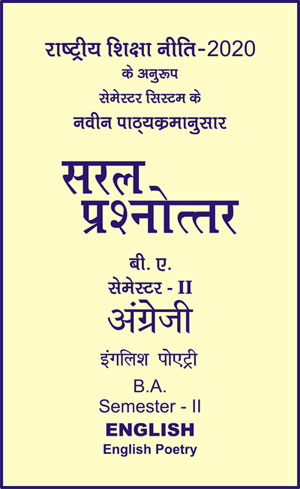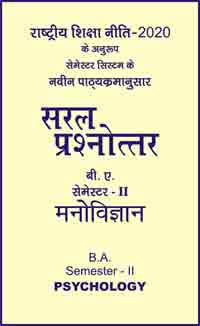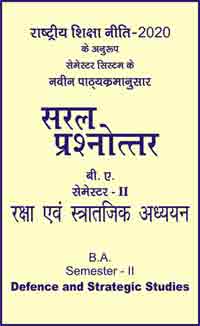|
बी ए - एम ए >> बीए सेमेस्टर-2 - अंग्रेजी - इंगलिश पोएट्री बीए सेमेस्टर-2 - अंग्रेजी - इंगलिश पोएट्रीसरल प्रश्नोत्तर समूह
|
5 पाठक हैं |
|||||||
बीए सेमेस्टर-2 - अंग्रेजी - इंगलिश पोएट्री
Chapter - 3
"Let Me Not to the Marriage of True Minds"
(Sonnet No. 116)
- William Shakespeare
Life and Works of William Shakespeare: In A Nut-Shell
Critics are not unanimous about the date of birth of William Shakespeare, but it was a assumed that he was baptized on the 26th of April, 1564, at the Holy Trinity church at Startford-on-Avon, most probably three days after his birth. So, it is generally believed that the poet was born on the 23rd of April, 1564. He was the third and eldest surviving child of his parents John Shakespeare and Mary Arden. His father, John Shakespeare was a dealer in hides, gloves, corn, wood, etc., and his mother Mary Arden, the daughter of a prosperous farmer.
Of Shakespeare's education we know little, except that for a few years, he probably attended the grammar school at Startford where he picked up the "small Latin and less Greek" to which his learned friend, Ben Jonson refers. His real teachers, meanwhile, were the men and women and the natural influences which surrounded him. The family, which through Mary Arden had some small landed property was at one time prosperous but when Shakespeare was about fourteen years old his father lost his property and fell into debt and the boy probably left school to support the family of yonger children, he being the eldest of six children Shakespeare himself married early. His bride was Anne Hathaway, the daughter of a peasant family. She was eight years older than her boy husband. They had three children and there is absolutely no documentary evidence of the slightest value as to the terms on which they lived together. But from numberous sarcastic reference to marriage made by the characters in his plays, and from the fact the he soon left his wife and family. It is generally alleged that his marriage was a hasty and unhappy one.
In 1584, Shakespeare left Startford. Why he did so, is not known. The most popular explanation, which appeared after his death, is that he was convicted of poaching on the estate of local magnate, Sir Thomas Lucy, and that he fled to escape the consequences. The ridicule heaped upon the Lucy family in 'Henry IV' and the Merry Wives of Windsor gives some weight to this tradition. Then, until 1592, when he reappeared, as a rising actor, Shakespeare, disappeared from the view. During this period, he is said to have wandered through the country, finally coming to London where he performed various menial offices including that of holding horses at the stage-door. The most recent attempt to bridge this gap in Shakespeare's life is a suggestion that he may have spent much of the time in the low countries on service with the armies of the Earl of Leicester.
The first authentic reference to him is in 1592 when Robert Greene, one of the popular playwrights of the time attacked him is a pamphlet called "A Groat's worth of wit bought with a million of repentance." Greene, who was nearing his end, pointed out to his fellows that "There is an upstart crow beautified with our feathers that with his :
Tiger's heart wrapped in a player's hide."
But apart from the favours of the patron, the success of the two poems, which appealed to a wider circle than acted plays, greatly improved Shakespeare's position, and from this time onward there is continued evidence of his increasing prosperity, and of his resolution to turns it to account by establishing himself as a land-owner in his native town. Within a decade of his unnoticed arrival in London, he was one of the most famous actors and literary men in England. The faculty which in the direction of poetry attains such early command seems, in the more complex and various departments of dramatic exercise, to have developed itself more slowly in proportion to the bulk and variety of its accomplishment. What really is, Shakespeare's earliest dramatic work is in the highest degree uncertain, and of the pieces which are with more or less probability ascibed to his earliest period it is not definitely known how much is his own, how much supplied by or borrowed from others. In any case, by 1598, he had produced enough plays to elicit the encomiums of a Cambridge Master of Arts, Francis, Meres who, in his Polladis Tamia, Wit's Treasury, published the same year, wrote:
"As the soul of Euphorbus was thought to live in Pythagoras, so the sweet, witty soul of ovid lives in mellifluous and honey-tongued Shakespeare', witness his Venus and Adonis, his Lucrace, his sugared sonnets among his private friends. As Plautus and Seneca are accounted the best for comedy and tragedy among the Latin's, so Shakespeare among the English is the most excellent in both kinds for the state; for comedy, witness his Gentlemen of Verona, his Comedy of Errors, his Love's Labour Lost, his Love's Labour's Won, his Midsummer Night's Dream and his Merchant of Venice; for tragedy his Richard (II), Richard (III), Henry (IV), King John, Titus Andronicus and his Romeo and Juliet."
The following table, which to a large extent is the outcome of generations of discussion and contention, represents a moderate or average estimate of the dates of the plays. It can be only an approximate estimate, for no exact decision is ever possible in this case.
| Name of the Plays. | Year |
|
Richard (III)
Comedy of Errors Titus Andronicus Taming of the Shew Two Gentlemen of Verona Love's Labour's Lost Romeo and Juliet Richard (II) Midsummer Night's Dream King John Merchant of Venice I and II Henry IV Much Ado About Nothing Henry (V) Julius Caesar As You Like It Twelfth Night Hamlet Merry Wives of Windsor Troilus and Cressida All's Well That Ends Well Measure for Measure Othello King Lear Macbeth Antony and Cleopatra Coriolanus Timor Pericles Cymbeline Winter's Tale Henry (VIII) Two Noble Kinsmen |
1592-94 1593-94 1594-95 1595-96 1596-97 1597-98 1598-99 1599-1600 1600-01 1601-02 1602-03 1604-05 1605-06 1606-07 1607-08 1608-09 1609-10 1610-11 1612-13 |
Shakespeare's Sonnets
Shakespeare wrote a series of sonnets, consisting of 154 sonnets. Out of 154, the first 126 are addressed to a young man, probably Lord William Herbert or Earl of Southampton these 126 sonnets trace the cours of the poet's affection for his young patron - a man of rank and beauty.
The remaining 28 sonnets celebrate the charm of a "Dark Lady". This Dark Lady did not respond to the poet's love. Who she was, it has never been discovered.
These sonnets were written between 1593 and 1596, but were printed in 1609 by Thomas Thrope.
In the first 126 sonnets, the poet “begs for his patron's favour, urges him to marry so that his charm and virtue may be perpetrated in his children, express a hope that the fame of his patron will live in his verse, declares that no frown from his noble friend will discourage him, and expresses jealousy for a rival poet who was seeking his favour.
In the remaining 28 sonnets, the poet celebrates the beauty and charm of the dark lady. Towards the end he refers to a rival poet who is seeking the favour of the poet's patron.
Let Me Not To The Marriage of True Minds
(Sonnet No. 116)
(Substance of the Poem)
Marriage is true love and the union of two souls. That love is not true love which changes with time. When one becomes disloyal, the love grows cold and indifferent. Here, Shakespeare refer to his beloved dark lady. She fell in love Earl of Southampton. Love is a permanent mark. It is like a light house that guides ships in the ocean and is never shaken by any storm. The Pole- star guides every sailor in the dark nights. The North star plays very significant role in the life of lovers. It guides the boats which are tossed by waves. Physical beauty decays with passage of time. It does not last long. But true love is immortal. It lasts till the last day of the world. The poet believes that true love exists and it never decays. If there is not true love, the poet would have never written poems and there was no man who loved someone sincerely and truly.
कविता का हिन्दी सारांश
विवाह सच्चा प्रेम है और दो आत्माओं का मिलन है। वह प्रेम सच्चा प्रेम नहीं है, जो समय के साथ परिवर्तित हो जाता है। जब एक धोखेबाज बन जाता है, तो प्रेम ठण्डा एवं उदासीन बन जाता है। यहाँ पर शेक्सपियर ने डार्क लेडी का जिक्र किया है। वह 'अर्ल ऑफ साउथेम्पटन' के प्रेम में पड़ गयी थी। प्रेम एक स्थायी चिन्ह है। यह प्रकाश-ग्रह के समान है जो समुद्र में जहाजों को मार्गदर्शित करता है और कभी भी तूफानों से नहीं हिलता है। ध्रुवतारा प्रेमियों के जीवन में महत्त्वपूर्ण भूमिका निभाता है। यह लहरों द्वारा हिला ई गयी नावों को रास्ता दिखाता है। शारीरिक सौन्दर्य समय के साथ नष्ट हो जाता है। वह दीर्घकाल तक नहीं चलता है। लेकिन सच्चा प्रेम अमर है। यह संसार के अन्तिम दिन तक चलता है। कवि का विश्वास है कि सच्चे प्रेम का अस्तित्व है और इसका क्षय कभी नहीं होता है। यदि संसार में सच्चा प्रेम नहीं होता तो कवि कभी नहीं लिखता और यहाँ पर किसी ने भी कभी सच्चा प्रेम नहीं किया होता।
Points To Ponder (About the Poem)
True love means the spiritual union of two hearts. It is constant. It survives among all the ups and downs of life.
Love is constant ideal which can be affected by nothing. It defines all untoward circumstances.
Even all destroying power of time cannot have any influence over love. It holds its own till the last day of judgement.
The poet asserts the sincerity of his own faith and love. He is sure that it is constant.
|
|||||
- Chapter - 1 Forms of Poetry & Stanza Forms
- Objective Type Questions
- Answers
- Chapter - 2 Poetic Device
- Objective Type Questions
- Answers
- Chapter - 3 "Let Me Not to the Marriage of True Minds" (Sonnet No. 116)
- Objective Type Questions
- Answers
- Chapter - 4 "On His Blindness"
- Objective Type Questions
- Answers
- Chapter - 5 "Present in Absence"
- Objective Type Questions
- Answers
- Chapter - 6 "Essay on Man”
- Objective Type Questions
- Answers
- Chapter - 7 "Elegy Written in a Country Churchyard”
- Objective Type Questions
- Answers
- Chapter - 8 "The World is Too Much with Us"
- Objective Type Questions
- Answers
- Chapter - 9 "Ode on a Grecian Urn"
- Objective Type Questions
- Answers
- Chapter - 10 "Break, Break, Break"
- Objective Type Questions
- Answers
- Chapter - 11 "How Do I Love Thee?"
- Objective Type Questions
- Answers
- Chapter - 12 "Dover Beach"
- Objective Type Questions
- Answers
- Chapter - 13 "My Last Duchess'
- Objective Type Questions
- Answers
- Chapter - 14 "The Love Song of J. Alfred Prufrock"
- Objective Type Questions
- Answers
- Chapter - 15 "The Lake Isle of Innisfree"
- Objective Type Questions
- Answers
- Chapter - 16 "Church Going"
- Objective Type Questions
- Answers
- Chapter - 17 Rhetoric and Prosody - Practical Criticism
- Objective Type Questions
- Answers














